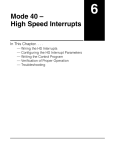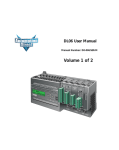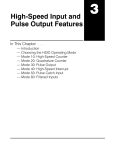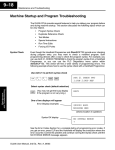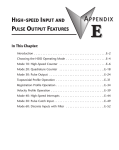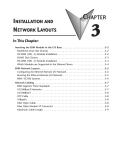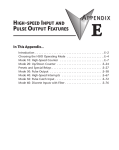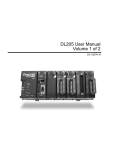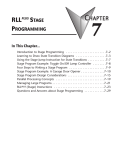Download Pulse 260 User manual
Transcript
Mode 50 – Pulse Catch Inputs In This Chapter. . . . Ċ Wiring the Pulse Catch Inputs Ċ Configuring the Pulse Catch Parameters Ċ Verification of Proper Operation Ċ Troubleshooting 17 7–2 Pulse Catch Input Mode 50 Pulse Catch Input Using the Pulse Catch Inputs, Mode 50 It is recommended that you read Chapter 1, Getting Started, which introduces the six different modes of operation of the D2–CTRINT module, before selecting a mode. Even though several features can be mixed from several modes, you must select one of the modes as your primary mode. Pulse Catch Input, Mode 50 will be the only mode covered in this chapter. It is also important to read Chapter 2, concerning the general guidelines for field wiring your device to the module. You may want to refer to Chapter 2 as you learn to make use of the D2-CTRINT’s Pulse Catch Inputs. A good place to begin is to learn what each channel of the module represents when it is being used in the Pulse Catch Input mode. Default Settings for Pulse Catch Input Mode 50 D2–CTRINT Terminals CW CCW DL240/250–1/260 DL230 00 00 Pulse Catch 01 D2 Dis. Input 02 03 Dis. Input Dis. Input 04 Pulse Catch 01 02 03 Pulse Catch Pulse Catch Pulse Catch 04 Not Used UP Counters Not Used Installation and Safety Guidelines Note: Refer to pages 2–4 and 2–5 when wiring your particular device. Shown in the above diagram and illustration are points 00 through 03 which default to pulse catch inputs when the module is used with the DL240/250–1/260 and set to operate in Mode 50. When the module is used with the DL230 only point 00 can be used for the pulse catch input, and the remaining channels can be used as discrete filtered inputs. Chapter 8 contains information about the filter time constant. When used with the DL240/250–1/260, the channels which are not configured as pulse catch inputs can be configured for many different functions, or as discrete filtered inputs. DL205 High Speed Counter Interface Manual, 2nd Ed, Rev. A 7–3 Pulse Catch Input Pulse Catching Explained The following example will help to explain the Pulse Catch Mode. Counting pulses in Mode 50 (Pulse Catch Input) Counting input pulses in the user program has some problems to be considered. X0 C0 CNT CT1 K9999 Pulse input to Point 00 Output Input Update Solve user logic Update Output Input Update Solve user logic Update Output Input Update Solve user logic Update Mode 50 Pulse Catch Input [Case 1] This is okay. X0 In this case, the pulse can be counted correctly. [Case 2] This is not okay. Pulse input to Point 00 Output Input Update Solve user logic Update Output Input Update Solve user logic Update Output Input Update Solve user logic Update X0 [Case 3] This also is not okay. Pulse input to Point 00 Output Input Update Solve user logic Update Output Input Update Solve user logic Update Output Input Update Solve user logic Update X0 Both of these pulses are also counted as one pulse. To count the pulses correctly, Mode 10 or Mode 20 should be used. DL205 High Speed Counter Interface Manual, 2nd Ed, Rev. A Installation and Safety Guidelines Both of these pulses are counted as one pulse. 7–4 Pulse Catch Input Mode 50 Pulse Catch Input Understanding V-Memory Setup Locations The Pulse Catch Input, Mode 50, associated with the D2-CTRINT requires V-memory configuration in order to be used. V-memory location V7633 is the most important of all the reserved memory areas because it stores the value which lets the CPU know which mode has been selected. The following diagram shows the 16–bit word and the various information it stores, including the values used for the Counter Interface Module. The example shown here uses the Pulse Catch Input, Mode 50, the lower and upper bits are set to 10 so the backup battery is enabled. Together they form the hexadecimal number 1050. Bits 15 14 13 Memory Location V7633 12 11 10 9 8 7 6 5 0 0 0 1 0 Installation and Safety Guidelines UP Counters 1 0 0 0 0 1 0 0 5 4 3 2 1 1 0 0 0 0 0 0 Miscellaneous Setup Binary Coded Decimal: D2-CTRINT Mode Setup Binary Coded Decimal: 00 = Not Used (default) 10 = Battery Enabled (DL230/240/250–1/260) 20 = Power Up in Run (DL230 only) 30 = Selects both Battery Enable and Power Up in Run (DL230 only) 40 = Mode Change Enable in K–sequence (DL240 only) 50 = Battery Enable and Mode Change Enable in K–sequence (DL240 only) 00 = Not Used 10 = UP Counting Mode 20 = UP/DOWN Counting Mode 30 = Pulse Output Train 40 = High Speed Interrupts 50 = Pulse Catch Inputs 60 = Discrete Filtered Inputs NOTE: It is important to look at the entire 16 bits at V7633. If the RLL program only sets the bits in the lower byte when entering the Counter Interface mode value, the upper bits will be overwritten with zeros (0’s). Always enter a 4-digit BCD value in the V-memory. This way, the proper value will be written into the upper bits. There are also other V-memory locations which contain Counter Interface setup information for each I/O point. They will be automatically configured with default values for each Counter Interface mode selected. DL205 High Speed Counter Interface Manual, 2nd Ed, Rev. A 7–5 Pulse Catch Input Default Settings When xx50 is written to V7633, the CPU places the following default codes in V-memory. Configuration Point 00/V7634 Point 01/V7635 Point 02/V7636 Point 03/V7637 Point 04 DL230 Hexadecimal Code Pulse Catch Input Not Used 0005 0000 DL240/250–1/260 Hexadecimal Code Pulse Catch Input Pulse Catch Input Pulse Catch Input Pulse Catch Input Not Used 0005 0005 0005 0005 Not Used 0000 Not Used 0000 Not Used CW D2–CTRINT Terminals CCW DL230 D2 DL240/250–1/260 00 00 Pulse Catch 01 Not Used 02 03 04 Not Used Not Used Not Used Pulse Catch 01 02 03 04 Mode 50 Pulse Catch Input Default Settings for Interrupt Input Mode 60 Pulse Catch Pulse Catch Pulse Catch Pulse Catch Note: Refer to pages 2–4 and 2–5 when wiring your particular device. Installation and Safety Guidelines DL205 High Speed Counter Interface Manual, 2nd Ed, Rev. A 7–6 Pulse Catch Input Custom Configuration Up to this point, only Mode 50 default settings have been discussed. The default settings will be suitable for many applications and will not require a custom configuration. However, for those applications needing the defaults changed so the D2–CTRINT will work for the applications, use the following table which contains the options available. UP Counters Mode 50 Pulse Catch Input Mode 50 Options Point Number V-Memory Location Possibility (One per point) Hex Value point 00 p V7634 Pulse Catch Input 0005 (DL240/250–1/260) default High Speed Interrupt (timed) ttt4 (ttt=1 to 999ms timer setting) Discrete Filtered Input xx06 (xx=filter time) High Speed Interrupt (DL240/250–1/260) 0004 Pulse Catch Input (DL240/250–1/260) 0005 (DL240/250–1/260) default Discrete Filtered Input xx06 (xx=filter time) High Speed Interrupt (DL240/250–1/260) 0004 Pulse Catch Input (DL240/250–1/260) 0005 (DL240/250–1/260) default Discrete Filtered Input xx06 (xx=filter time) High Speed Interrupt (DL240/250–1/260) 0004 Pulse Catch Input (DL240/250–1/260) 0005 (DL240/250–1/260) default High Speed Interrupt (DL240/250–1/260) 0004 Discrete Filtered Input xx06 (xx=filter time) Not available in Mode 50 –––– point 01 point 02 Installation and Safety Guidelines point 03 point 04 V7635 V7636 V7637 V7637 DL205 High Speed Counter Interface Manual, 2nd Ed, Rev. A 7–7 Pulse Catch Input Setting UP the CPU for the Pulse Catch Inputs Configuring the V–Memory Mode 50 Pulse Catch Input Step 1: Enter the Mode Selected The DL240, DL250–1 or DL260 CPUs checks the V-memory to see if there is a D2–CTRINT Module present. There will be the value 10, 20, 30, 40, 50 or 60 in V7633 if the module has been properly configured. If the CPU finds that a Counter Interface module is present, other V-memory locations will be checked to see how the module has been configured. The values can be entered into memory by using either a handheld programmer or by editing them into a control program using DirectSOFT32. The following examples will show how to use DirectSOFT32 to configure the Pulse Catch Inputs. If Mode 50, Pulse Catch Input, has been chosen as the primary function, the value 50 must be placed in V7633. The following DirectSOFT32 diagram shows the setup procedures for communicating with the DL240/250–1/260 CPU. Refer to the DirectSOFT32 Programmers User Manual for more details. Setting the V-Memory using RLL Installation and Safety Guidelines Setting the V-Memory using the Memory Editor Editing the D2–CTRINT setup at the beginning of the user program is the most efficient method for setting up the counter mode. Should there be a need to change any of the counter setup values after the PLC has been put in the RUN Mode, use the Memory Editor to change the values. These values will only be temporary. They should be put into the program if they are to be used permanently. DL205 High Speed Counter Interface Manual, 2nd Ed, Rev. A 7–8 Pulse Catch Input The following RLL example shows how to set the Pulse Catch Input, Mode 50, in V–memory location V7633. DirectSOFT32 Display SP0 LD K50 Load Mode 50 in Accumulator OUT V7633 UP Counters Mode 50 Pulse Catch Input Transfer Contents of Accumulator to V7633 Two commands are needed to put the values into V-memory. The value must first be loaded into the accumulator of the CPU, then the CPU must transfer the value to the memory location. In this case, 50 is to be placed in V7633. This value is loaded into the accumulator, LD K50. The CPU then writes this data to the memory location V7633, once it reads the OUT command, OUT V7633. Notice that an SP0 contact is used in this rung. This relay is on for the first scan only. This will load the values into memory initially, thereby keeping the scan time to a minimum. Step 2: How Many Pulse Catch Inputs Up to four(4) pulse catch inputs can be used with the DL240/250–1/260 CPUs and one (1) pulse catch input for the DL230 CPU. The following steps will discuss the programming for each channel which has an interrupt device wired to it. Step 3: Configure the V-Memory The table below gives a description for each of the V-memory locations that must be configured for each I/O point which are selected to have high speed interrupt capability. Installation and Safety Guidelines V–Memory Description V7633 Primary Mode (Pulse Catch=50) V7634 Point 00 V7635 Point 01 V7636 Point 02 V7637 Point 03 DL205 High Speed Counter Interface Manual, 2nd Ed, Rev. A 7–9 Pulse Catch Input In the below example, Channels 1 and 2 are configured as Pulse Catch Inputs, Channel 3 is to be a Discrete Filtered Input, and Channel 4 to be an Interrupt Input. DirectSOFT32 Display SP0 LD K5 OUT V7634 Pulse Catch Input at Point 00 LD K5 OUT V7635 Pulse Catch Input at Point 01 LD External Interrupt at Point 02 LD K1006 OUT V7637 Discrete Input w/10 ms filter; at Point 03 Mode 50 Pulse Catch Input K4 OUT V7636 Notice that the hex number 5 is stored in the V-memory locations for each I/O point which are to be Pulse Catch Inputs. The number 4 is used for an external interrupt at an I/O point, and Kxx06 is used for a programmable discrete filtered input (where xx represents the filtering time constant in milliseconds.) Installation and Safety Guidelines DL205 High Speed Counter Interface Manual, 2nd Ed, Rev. A 7–10 Pulse Catch Input Installation and Safety Guidelines UP Counters Mode 50 Pulse Catch Input Troubleshooting The following information may provide some assistance in handling any problems which may be encountered when setting up the D2–CTRINT module, should they occur. Experience has shown that most problems occur because of improper configuration. Always re-check configuration before anything else. For verifying types of inputs (or outputs) which do not relate to the Pulse Catch Input, see the Chapters in this manual covering the specific function. Listed below are some things that could possibly go wrong with the high speed interrupt inputs: 1. No pulse catching appears to be taking place. 2. The status indicator LED is not lit for the input point where the pulse catching is wired (i.e. points 00 and 01). Defective Field Device - If a field device is suspected to be faulty, verify its proper operation first. Examine the characteristics of the pulses being received with an oscilloscope, test equipment type digital counter, or an inexpensive logic probe. Touch probe to counter input points. Field device must be wired so that pulses are being sent. Typical Low Cost Logic Probe (Not available from AutomationDirect) High Signal Indicator Low Signal Indicator Pulse Train Indicator Normal/Pulse Train Switch TTL/CMOS Switch Connect power leads to your recommended power supply––not PLC power supply. Check the specifications for the field device. Make certain that the output signal matches the specifications of the D2–CTRINT module. Pulse Width – The pulse width may be too narrow. The positive transition must remain HIGH for at least 0.1 ms in order for the module to detect its presence. Wiring - Simple as this might seem, quite often poor wiring is the cause of many problems. Be sure there is a complete electrical loop between the device and the input module. Along with visual inspection, use a voltmeter to check the wiring. Input Voltage - If the input device is sending a signal that is less than 12 volts, most likely the counter will not function or function improperly. Replace the field device with one which has the proper output level if necessary. Improper Configuration - Verify that proper values have been used in the configuration. If interfacing a DL230, point 00 is the only point available for pulse catching. Status Indicators – Make sure the PWR or BAT LED’s are not lit on the CPU. Be sure that the status indicators are lit as the pulse signals are received at the proper input point on the D2–CTRINT module. If an LED is not functioning, check the point with a voltmeter to be sure that the I/O point is being energized. . DL205 High Speed Counter Interface Manual, 2nd Ed, Rev. A










